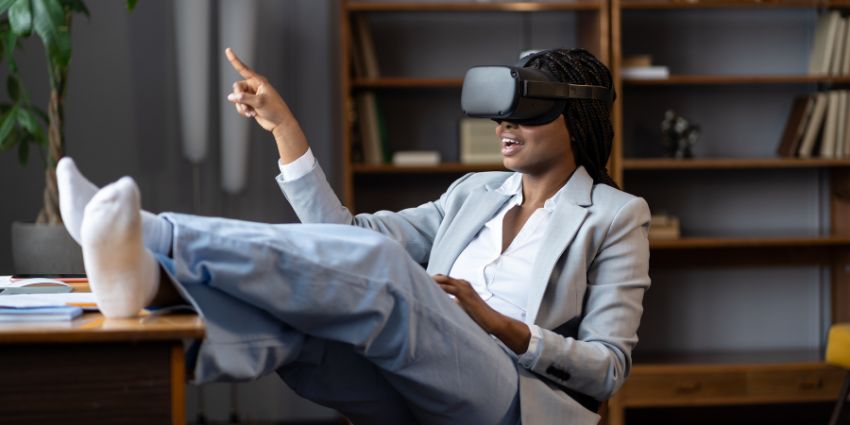The “future of work” is no longer a sci-fi concept, but something every business needs to be intimately familiar with. Over the last couple of years, the traditional “workplace” has all but disappeared, replaced with ever-more flexible, agile modes of operation.
In an environment where the cloud can connect us to all the tools we need to remain productive wherever we are, and employees are looking for more versatility in their roles, we’ve seen a rising demand for remote working solutions. McKinsey found when people have a chance to work flexibly, around 87% of employees will take advantage.
Unfortunately, while flexible and remote working options can generate new opportunities for brands, boosting productivity, employee engagement, and talent retention, they also have unique challenges to address. For instance, how do you preserve company culture and motivate teams when your employees are distributed across multiple global points?
XR (Extended Reality), could have the answer.
How XR Influences the Remote Working World
XR, like remote working, has seen significant growth in recent years.
Once considered a novelty for the gaming and entertainment industry, XR has now evolved into a core component of many business transformation strategies. Indeed, XR device shipments are expected increase to around 105 million by 2025 alone.
The extended reality landscape provides companies with access to an array of valuable tools they can use to connect, align, and motivate their teams. AR (Augmented Reality) applications can help team members bring virtual content into the physical environment to assist with decision making and innovation. MR (Mixed Reality) tools are opening the door to a future where teams may one day be able to communicate with holographic representations of their peers.
VR (Virtual Reality) has already begun to assist countless companies in bringing team members together in digital environments, where they can build new prototypes of products, share ideas, and connect with express themselves through hyper-realistic avatars.
As concepts like the “metaverse” continue to influence the way we think about the future workplace, demand for immersive XR experiences will only continue to grow. In the future, the workplace may no longer be a physical space, but a virtual environment where anyone and everyone can thrive.
The Benefits of Remote Worker XR Tools
Perhaps the biggest benefits of XR tools for remote work, is that they provide distributed teams with new ways to overcome the challenges associated with working outside of the office.
After all, while remote work does give employees access to more work/life balance and freedom, it can also have a host of issues, leading team members to feel more isolated, or detached from the companies they work with.
Implementing XR into the workplace allows companies to recreate the sense of “presence” missing from remote interactions. While video and audio conferencing have gone some way towards bridging the gap between distributed teams, they still don’t provide people with a comprehensive environment where they can connect and thrive.
With remote worker XR tools, businesses can create the next generation of the workplace, and benefit from:
1. Enhanced Collaboration
Existing collaboration tools allow team members to interact via video, audio, and messaging, share files, and plan projects in a virtual environment. However, XR solutions can take this collaborative experience to the next level. Companies can create digital twins of their office environments where team members can connect with their colleagues, and share ideas.
Businesses can build infinitely flexible landscapes, where teams can build new product prototypes without worrying about material costs or waste. Already, automotive brands and manufacturing companies are using VR solutions to help teams rapidly imagine and create new products and solutions for customers, without restrictions.
2. Improved Company Culture
While 44% of professionals consider remote and hybrid working to be beneficial. Yet, one in five also say they’re worried about missing out on opportunities when they’re not in the office. The age of remote work has led to a generation of more disconnected, isolated employees, who struggle to feel deeply connected to their teams. This is leading to a host of problems with company culture, including rising concerns about proximity bias.
The XR environment provides a landscape where people can generate real, meaningful connections with their colleagues, regardless of where they are. Staff can engage in gamified experiences to build morale, or simply interact with their colleagues in a space where everyone can feel truly seen and heard. XR tools can even integrate with existing collaboration apps, to provide users with access to things like real-time translation and captions, for better accessibility.
3. Upskilling and Reskilling Employees
As the world continues to evolve, and industries continue to adopt new technologies and innovations, businesses are under increasing pressure to train their team members. Unfortunately, when team members are remote, it can be difficult to provide them with the same hands-on training experiences which generate excellent knowledge retention and skill development.
Studies have already found using VR for training leads to 27.4% higher test scores on average for most students. Companies can use XR solutions to create realistic simulated environments, where employees can engage in all forms of training, risk-free. Since providing consistent training and development opportunities is also one of the best ways to retain employees, implementing these strategies could be an effective way for businesses to keep hold of their top talent.
4. Recruitment and Onboarding
Finally, the world of remote work opens up endless doors for companies to hire a more diverse selection of specialists from different landscapes and environments. Businesses no longer have to rely exclusively on the talent closest to their office to fill their team.
However, in order to truly make the most of remote employees, companies need to ensure their hiring and onboarding strategy is up-to-date. While video interviews and digital onboarding tools can be helpful, few things are more effective at immersing a new hire into a company’s culture than XR. With a VR headset, potential staff members can experience a work day at a business without having to visit an office in person. AR solutions can provide employees with immersive training and learning opportunities during onboarding, and MR can bring HR professionals to staff wherever they are.
XR Is the Future of Remote Work
It’s safe to say demand for flexible and remote working opportunities is unlikely to diminish in the years ahead. The benefits of a more agile and digital workforce are too appealing for companies and their employees to pass up. However, if companies want to get the most out of their distributed workforce, they need to be willing to embrace the right technology.
XR has the potential to improve everything from the initial hiring and onboarding process to training for remote workers, collaboration between teams, and more. Used correctly, it can even improve employee engagement and experiences. XR could well be the future of remote work.







